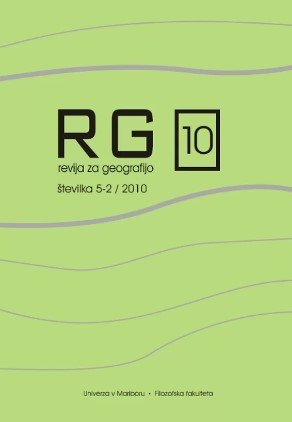Ecological efficiency of production and the ecological footprint of organic agriculture
Abstract
The rising energy prices and climatic changes have intensified the search for alternative farming systems where energy consumption per unit would be lowered. A long-term field trial, started in 2007 at the University of Maribor, focuses on food quality and the ecological footprint of conventional (CON), integrated (INT), organic (ORG) and biodynamic (BD) farming systems. The gained data has been evaluated and interpreted using the SPIonExcel tool. Results from the first year show better environmental performance of both, ORG and BD systems in production of wheat (Triticum aestivum L.) and spelt (Triticum spelta L.), mainly due to the non-use of external synthetic production factors. When yields are added to the equation, the ORG and BD systems emerge also as more efficient per unit of land area. Thus, the ORG and BD farming systems present viable alternatives for reducing the impact of agriculture on climate change, while ensuring a more sustainable food security.
Downloads
References
Avery, A. 2007: Organic abundance report: fatally flawed. Renewable Agriculture and Food Systems, 22(4), p. 321-323. https://doi.org/10.1017/S1742170507002189
Badgley, C. et al 2007: Organic Agriculture and the Global Food Supply. Renewable Agriculture and Food Systems, 22(02), p. 86-108. https://doi.org/10.1017/S1742170507001640
Chen, G. et al 2009: Exergetic assessment for ecological economic system: Chinese agriculture. Ecological Modelling, 220(3), p. 397-410.
Curran, M. 2008: Life-Cycle Assessment. In: Encyclopedia of Ecology. Oxford, Aca-demic Press, p. 2168-2174. https://doi.org/10.1016/B978-008045405-4.00629-7
Demeter International e.V. 2009: Production Standards for the use of Demeter, Biodynamic and related trademarks. Available at: http://demeter.net/standards/st_production_e09.pdf.
EC 834/2007, 2007: Council Regulation (EC) No. 834/2007 of 28 June 2007 on organic production and labelling of organic products and repealing Regulation (EEC) No. 2092/91. Available at: http://eur-ex.europa.eu/LexUriServ/LexUriServ.do?uri=OJ:L:2007:189:0001:0023:EN:PDF (February 2, 2009).
Goodchild, P. 2007: Peak Oil And Famine: Four Billion Deaths. Available at: http://www.countercurrents.org/goodchild291007.htm (Accessed September 20, 2009).
Haberl, H., Erb, K., Krausmann, F. 2001: How to calculate and interpret ecological footprints for long periods of time: the case of Austria 1926-1995. Ecological Economics, 38(1), p. 25-45.
Hoshmand, A. R. 2006: Design of Experiments for Agriculture and the Natural Sciences Second Edition 2nd ed.. Chapman & Hall/CRC. https://doi.org/10.1201/9781315276021
Krotscheck, C., Narodoslawsky, M. 1996: The Sustainable Process Index a new di-mension in ecological evaluation. Ecological Engineering, 6(4), p. 241-258.
Lenzen, M., Murray, S. A. 2001: A modified ecological footprint method and its application to Australia. Ecological Economics, 37(2), p. 229-255.
MKGP, 2004. Pravilnik o integrirani pridelavi poljščin. Available at: http://www.uradni-list.si/1/objava.jsp?urlid=200410&stevilka=438 (Accessed February 2, 2009).
MKGP, 2002: Pravilnik o integrirani pridelavi zelenjave. Available at: http://www.uradni-list.si/1/objava.jsp?urlid=200263&stevilka=3051.
MKGP, 2008: Zakon o kmetijstvu. Available at: http://www.uradni-list.si/1/objava.jsp?urlid=200845&stevilka=1978 [Accessed September 20, 2009].
Narodoslawsky, M., Krotscheck, C. 1995: The sustainable process index (SPI): evaluating processes according to environmental compatibility. Journal of Hazardous Materials, 41(2-3), p. 383-397.
Sandholzer, D., Narodoslawsky, M. 2007: SPIonExcel-Fast and easy calculation of the Sustainable Process Index via computer. Resources, Conservation and Recycling, 50(2), p. 130-142.
UNEP, 1992: Rio Declaration on Environment and Development. Available at: http://www.unep.org/Documents.Multilingual/Default.asp?documentID=78&articleID=1163.
UNPP, 2008: World Population Prospects: The 2008 Revision Population Database. Available at: http://esa.un.org/unpp/.
Veleva, V. et al 2001: Indicators of sustainable production. Journal of Cleaner Production, 9(5), p. 447-452. https://doi.org/10.1016/S0959-6526(01)00010-5
Veleva, V., Bailey, J., Jurczyk, N. 2001: Using Sustainable Production Indicators to Measure Progress in ISO 14001, EHS System and EPA Achievement Track. Corporate Environmental Strategy, 8(4), p. 326-338.
Wackernagel, M., Rees, W.E. 1996: Our écological footprint, New Society Publishers.
WCED, 1987: Our Common Future, Oxford Paperbacks.
Van der Werf, H.M. et al. 2007: Environmental impacts of farm scenarios according to five assessment methods. Agriculture, Ecosystems & Environment, 118(1-4), p. 327-338. https://doi.org/10.1016/j.agee.2006.06.005
Willer, H. et al. 2009: The European Market for Organic Food and Drink. Available at: http://orgprints.org/15482/ (Accessed September 20, 2009).
Copyright (c) 2010 Matjaž Turinek, Maja Turinek, Silva Grobelnik Mlakar, Franc Bavec, Martina Bavec

This work is licensed under a Creative Commons Attribution 4.0 International License.
